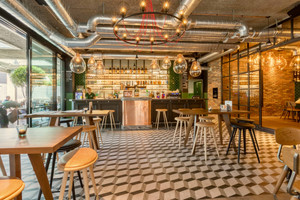
The Art of Entry: How Swinging Doors Transform Spaces
The Art of Entry: How Swinging Doors Transform Spaces

Interior design is a symphony of elements playing in harmony. Among the many tools in a designer's arsenal, doors often get overlooked. Yet, they wield a significant influence on the functionality and aesthetics of a space, with few door types being as versatile as the swinging door. In this exploration, we take a closer look at how swinging doors aren't just a point of entry; they are an integral part of the design narrative.
Swinging Doors in Residential Applications
At home, swinging doors are more than just a means to enter or exit a room. They demarcate zones, adding privacy without fully partitioning spaces, and allow for a flow that's both connected and flexible. Here are a few ways swinging doors can be a game-changer for residences.
Harmonizing Open-Plan Living
The popularity of open-plan living cannot be overstated, with its appeal lying in spaciousness and the sense of togetherness it fosters. Yet, there are times when a touch of division is welcome. Swinging doors offer a perfect balance by being present only when necessary, while still allowing for a cohesive space when open.
Consider swinging doors to connect and separate the kitchen from the living area. While open, they keep both areas visually and physically linked, but when privacy or containment of noise and smells is needed, they provide a straightforward solution.
Elevating Home Entrances
The first impression any home offers is at the entrance. Swinging doors can transform a mundane entry into a statement. Whether it's a French door leading from the foyer to the living room or a rustic saloon-style door for the pantry, these doors give an immediate indication of the home's character and style. They can be an introduction to the interior style, a harbinger of an alpine lodge, or a mid-century modern living room.
Reflecting Personal Style
Residential spaces are a canvas for personal expression. Swinging doors, whether pocket, bi-fold, or traditional hinged, are customizations waiting to happen. For those looking to make a statement, a well-crafted door with ornate trims or a pop of color can become the focal point of a room. Modern design enthusiasts may prefer sleek and simple frameless doors that blend in yet retain their functionality.
Commercial and Industrial Uses
 Swinging doors extend their influence far beyond residential settings, finding a plethora of functions in commercial and industrial environments. Here they tackle the challenges of traffic flow, accessibility, and privacy in entirely new ways.
Swinging doors extend their influence far beyond residential settings, finding a plethora of functions in commercial and industrial environments. Here they tackle the challenges of traffic flow, accessibility, and privacy in entirely new ways.
Managing Foot Traffic in Retail
In bustling retail environments, managing the flow of customers is a delicate choreography. Swinging doors can be non-verbal cues that guide customer behavior. Pair a push/pull swinging door with the right signage, and you can encourage people to move in an orderly fashion, reducing congestion.
Enhancing Workspace Dynamics
Swinging doors within office spaces can foster a flexible work environment. Conference rooms with well-hung doors can switch from private to open with minimal effort, reflecting the collaborative nature of modern work culture. Soundproof options provide privacy for phone calls and meetings, optimizing the acoustics within a busy office.
Adapting to Industry Requirements
In the industrial context, swinging doors often need to meet stringent requirements for durability, hygiene, and isolation. From the use of specially designed double-action doors in hospitals to rapid roll-up doors in warehouses, the variety of swinging doors that exist can adapt to the specific needs of the industry, ensuring both efficiency and safety.
Public Spaces and Institutions
Finally, in public spaces and institutional settings, swinging doors serve broader agendas such as accessibility, safety, and even historical preservation.
Accessibility and ADA Compliance
For public buildings and institutions, particularly those with a high volume of traffic, swinging doors provide easy access and can comply with the regulations set out by the ADA (Americans with Disabilities Act) and similar accessibility standards worldwide. The careful selection and proper installation of automatic or push/pull doors can make a monumental difference for the mobility-challenged, the elderly, and those with temporary disabilities or young children.
Safety and Traffic Control
In high-security areas, doors play a role not just in entry but also in controlling the movement of individuals. Swinging doors with integrated locking systems or turnstiles can regulate the flow according to the needs of the facility, while still offering a clear line of sight for security personnel.
Preservation and Conservation
Public spaces with historical significance often require a delicate balance between preserving the integrity of the structure and meeting the modern requirements of usage. Swinging doors offer a controlled way to segregate areas, thereby managing foot traffic and the conservation of space and materials. They can be manufactured to replicate the look of original doors while being updated with the necessary technology for ease of use and security.
In conclusion, swinging doors are like the punctuation marks in the narrative of a space. They can emphasize, defer, connect, or even stand out. Whether in a home, a bustling store, or a solemn courthouse, the choFrench
